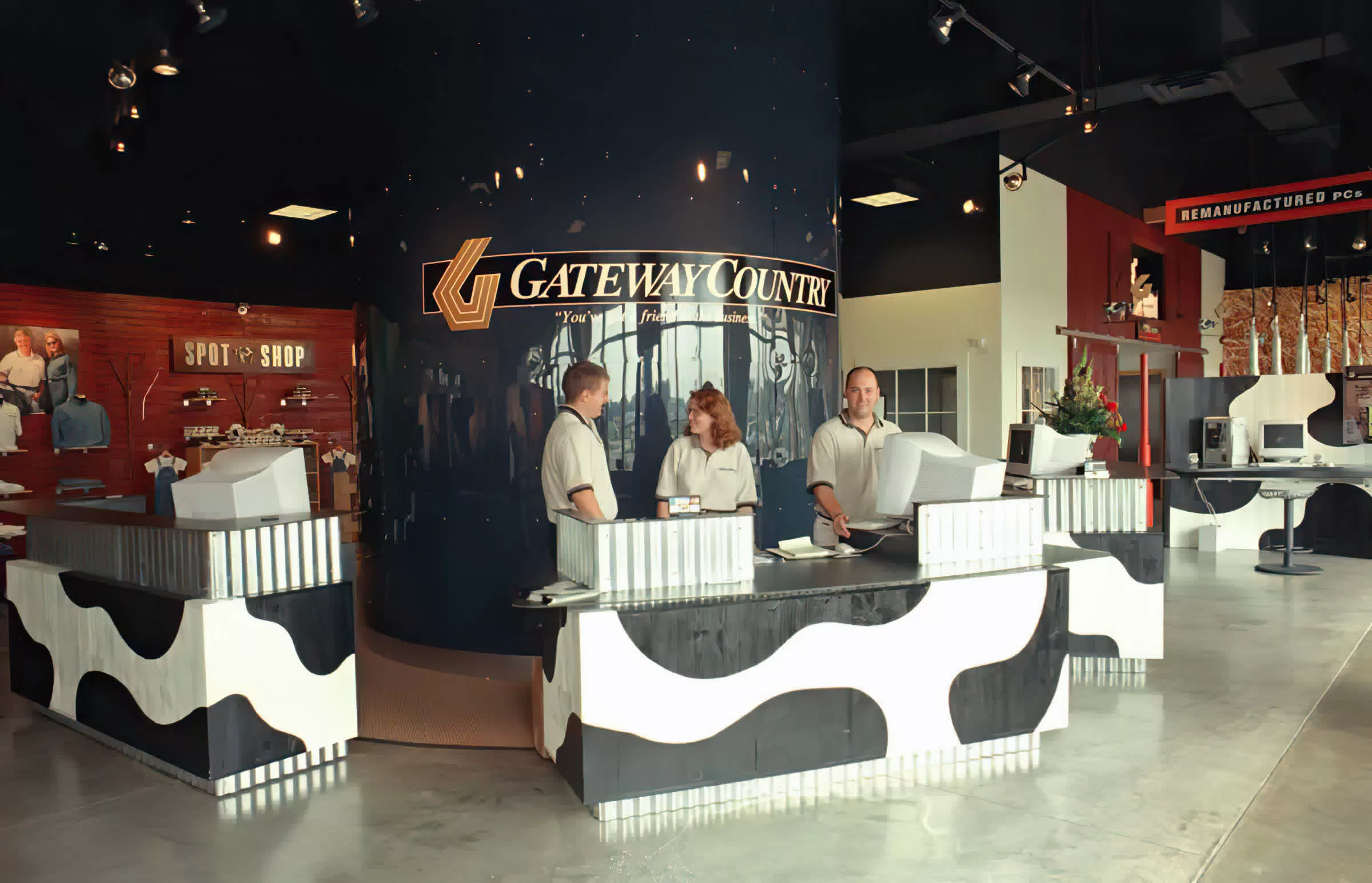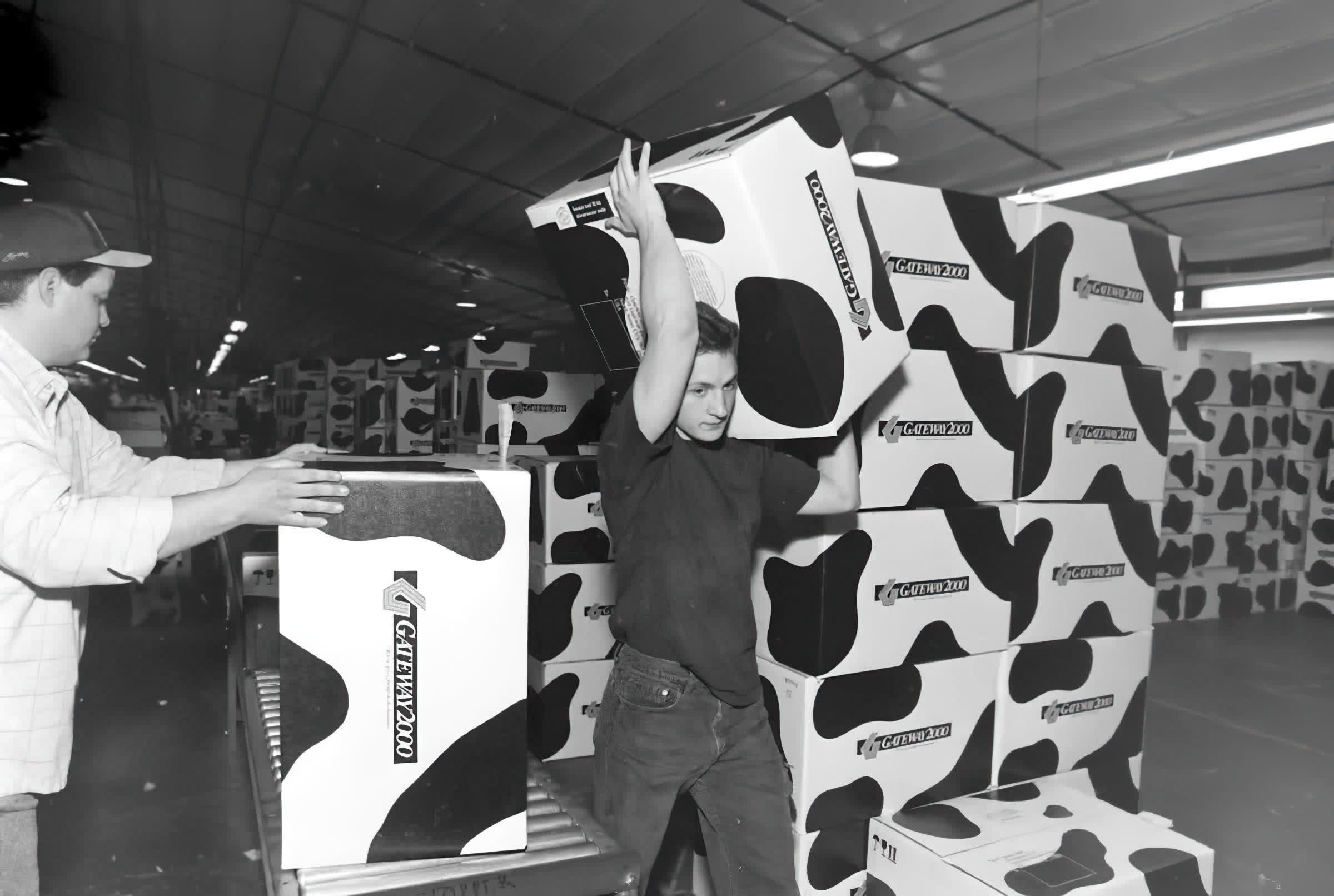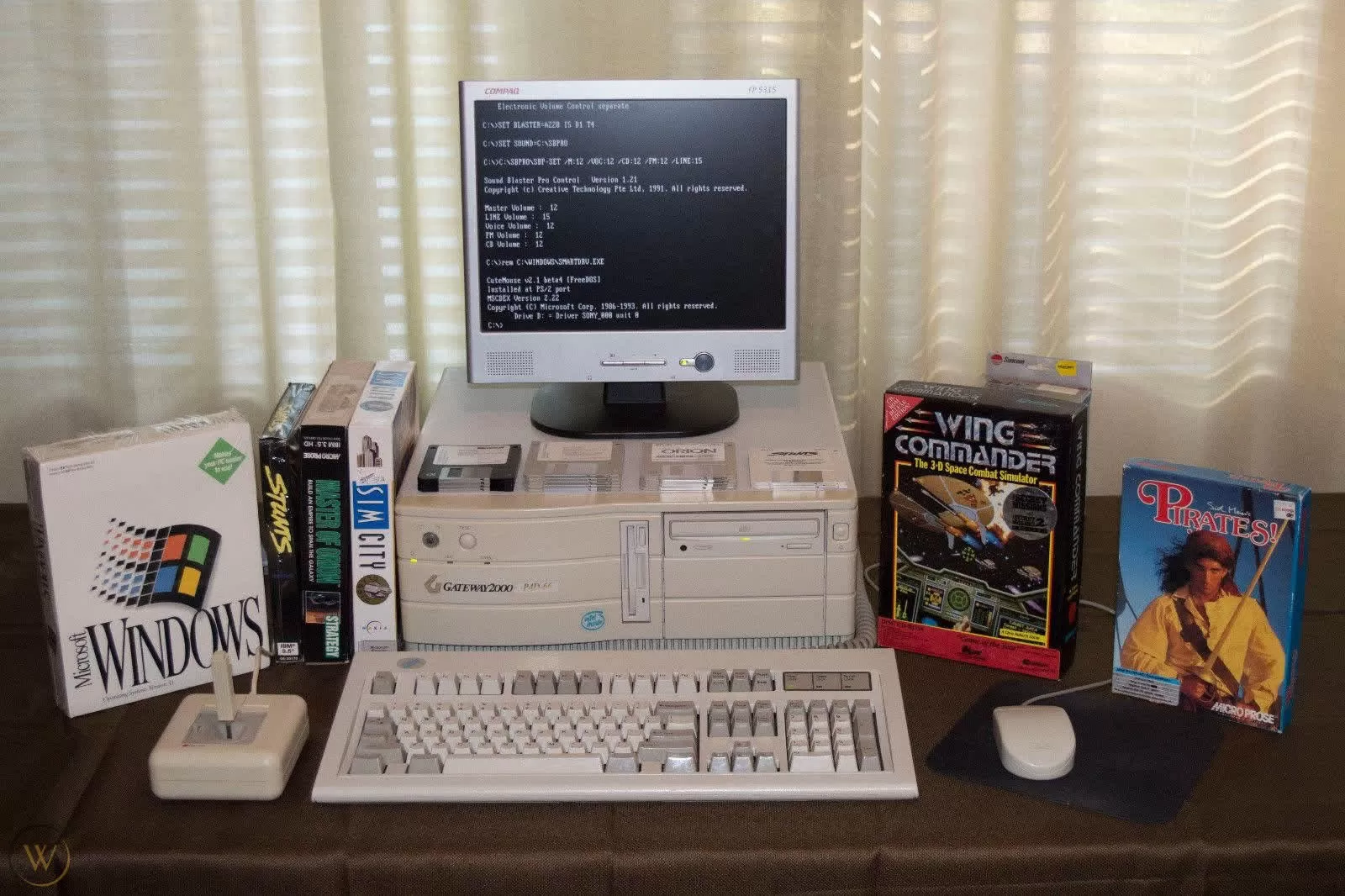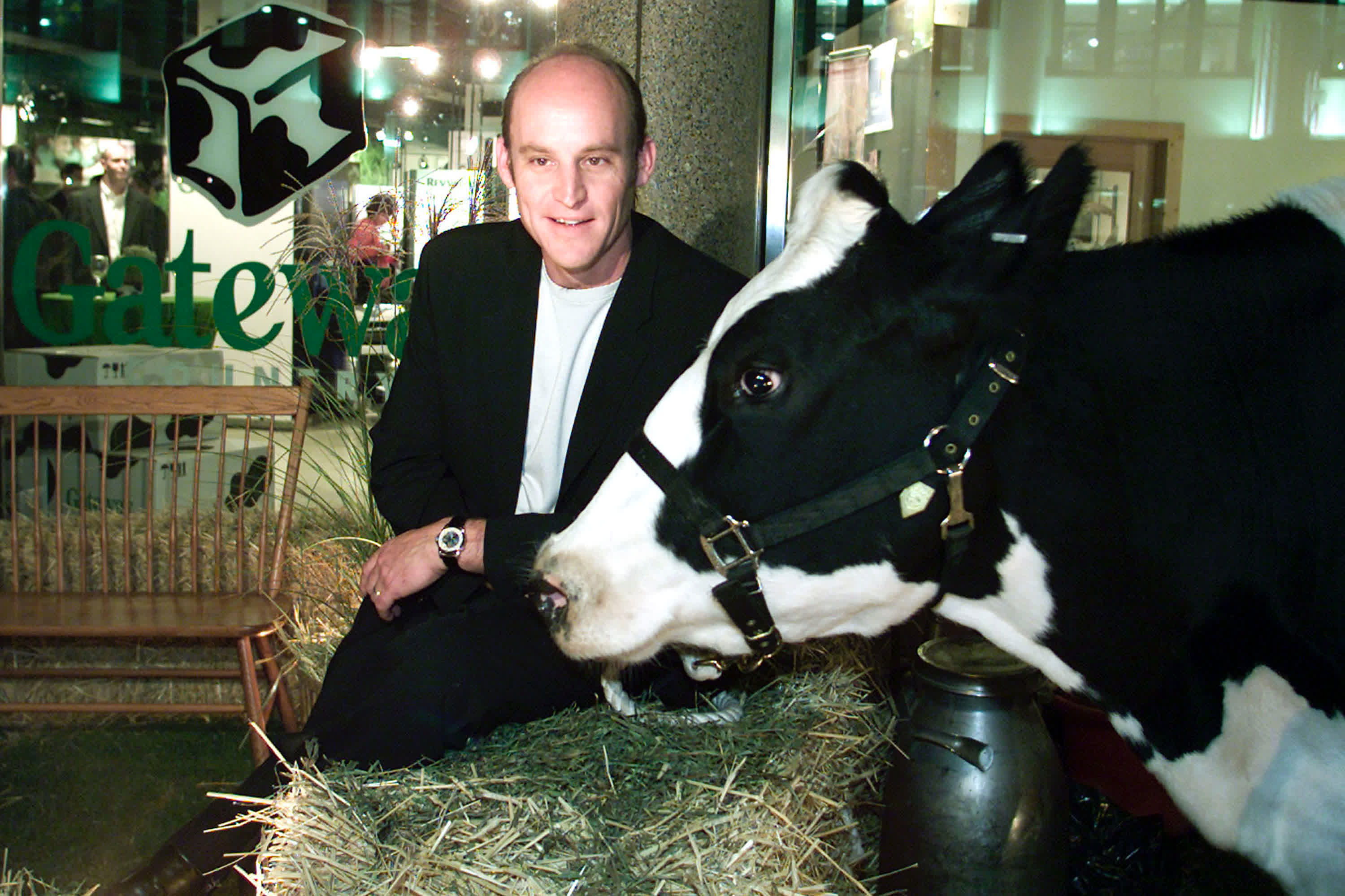What does a cattle ranch have Lee Doin common with computers? Admittedly not much, but that didn't stop a couple of college dropouts from capitalizing on the concept to create a lucrative business that would reshape how consumers perceive and purchase personal computers.
A chance encounter between Ted Waitt, a University of Iowa sophomore studying marketing and business, and Mike Hammond, a computer store employee in Des Moines, in the fall of 1984 would lead to the two going into business together less than a year later.
The company they founded, TIPC Network, was a computer mail-order business that launched on September 5, 1985. Waitt's grandmother, Mildred Smith (known as "Mo Mo" to her grandchildren), put up her $15,000 certificate of deposit as collateral to secure a $10,000 loan used to get the operation off the ground. Waitt's father allowed the duo to run the business out of a two-story farmhouse on his cattle ranch.

Against all odds, the Iowa-based firm, which utilized a business model similar to Dell direct sales, was a hit from the beginning, raking in $100,000 in sales in just four months.
In February 1986, Waitt's brother, Norm Jr., was brought on as a full partner to handle the company's finances. Soon enough, the trio started selling custom-built PCs for cheaper than enthusiasts could build them at home and changed their company name to Gateway 2000.
Gateway's big break came the following year when they ran a rather unique advertisement in Computer Shopper magazine.
The full-page ad featured an image of Waitt Sr.'s cattle ranch and highlighted the company's most popular configuration, the Gateway 2000 A12 with a 12 MHz 80286 processor, 1 MB of RAM, a 40 MB hard drive and a 14-inch monitor for $1,995.

The unconventional ad stood out like a sore thumb in the traditionally "techie" magazine, and no, that wasn't a bad thing. Consumers responded favorably to Gateway's homegrown vibe to the tune of $12 million in sales in 1988.
Gateway quickly outgrew its farmhouse headquarters, eventually moving to a 15,000-square-foot office building near Sioux Gateway Airport. With more space and more employees on payroll, they were able to get way more work done. Fortunately, the demand was there – and then some.
In 1989, Gateway generated $70 million in sales, which again prompted the company to relocate its headquarters, this time to a 33,000-square-foot plant in North Sioux City in South Dakota. Because the state didn't have a personal or corporate income tax, they were able to save a significant amount of money and better compete with rivals.
Gateway was essentially a rocketship by that point and its creators were doing their best just to hang on for the ride. By the end of 1990, sales had quadrupled to $275 million and a year later, that figure had swelled to a staggering $626 million. In 1992, the company surpassed a billion dollars in sales for the first time.
Half a decade before the Holstein dairy cow found employment with fast food restaurant chain Chick-fil-A, Gateway put the cows to work as part of their extended homegrown marketing strategy. Inexpensive PCs would ship to customers in black and white boxes resembling the markings on the dairy cows and because they only used two colors, it saved on packaging costs.
Gateway pioneered how people bought computers, too.
For a while, the cow pattern was as synonymous with Gateway as the swoosh is with Nike, or the golden arch is to McDonald's. Gateway prided itself on a new-age way of serving customers, building PCs to fit a buyer's needs and backing their systems with excellent customer and tech support.

Gateway pioneered howpeople bought computers, too.
In 1996, Gateway introduced its Gateway Country retail store concept. The barn-like stores, which predated Apple's standalone retail effort by half a decade and Microsoft's stores by more than a dozen years, were staffed with employees who knew the ins and outs of what they were selling. They were initially a big hit with consumers and within five years, there were more than 300 stores doing business across the country.


In 1998, the company dropped the "2000" moniker from its name to avoid dating itself with the pending turn of the century, the first of many changes for the PC maker. Another big change - the decision to move its headquarters from the Midwest to San Diego, California - would have a much longer lasting impact.
In a 2007 interview with the Sioux City Journal, Ted Waitt said the executives in San Diego never fully got on board with the value-driven culture that initially drove Gateway. "It was much more money-oriented. It was much more short-term oriented," Waitt noted.

In October 1999, Gateway announced a strategic partnership with AOL to market the company's online service on all of its new computers. The deal was valued at $800 million over a two-year period. Around the same time, Waitt stepped down as CEO, handing the reins over to Jeffrey Weitzen. Waitt told the Journal that in hindsight, selecting some of the people he did to run the business at that time was "just as stupid" as their decision to move to California.
"They overmanaged and screwed it up. They did things short-term to make the income sheet look better, which damaged the balance sheet, which sold the future of the business. So, when times got tough, there wasn't as much to rely on." - Ted Waitt, late 2007.
Waitt would return in early 2001 to try and recover from the $94.3 million loss Gateway suffered in the fourth quarter of 2000, no doubt compounded by the dot-com bubble burst. The firm downsized and experimented with selling more generalized consumer electronics like digital cameras and plasma televisions but didn't find sustainable success.

In a last-ditch effort to save the company, Gateway purchased budget computer builder eMachines in a deal valued at around $234 million. Waitt again stepped down as CEO, making way for eMachines chief Wayne Inouye to run the show.
Gateway never returned to the limelight and in 2007, the company was sold to Taiwanese firm Acer for $710 million. Gateway technically still exists today but only as a shell of its former self. Acer hasn't bothered to update Gateway's website in years, seemingly content to let the asset fall victim to Father Time. Mike Hammond, Gateway's co-founder, died in 2015 at the age of 53.
 Operation Mensch
Operation Mensch
 Luxshare producing three iPhone 15 models, preparing for Apple Vision Pro production · TechNode
Luxshare producing three iPhone 15 models, preparing for Apple Vision Pro production · TechNode
 Nadal vs. Lehecka 2024 livestream: Watch Madrid Open for free
Nadal vs. Lehecka 2024 livestream: Watch Madrid Open for free
 China’s Chery Auto to enter Thailand in first half of 2024: executive · TechNode
China’s Chery Auto to enter Thailand in first half of 2024: executive · TechNode
 Gods of War
Gods of War
 Amazon deals of the day: Narwal Freo X Ultra, Apple Pencil, Echo Dot, and JBL Clip 4
Amazon deals of the day: Narwal Freo X Ultra, Apple Pencil, Echo Dot, and JBL Clip 4
 Former WTO chief expects anti
Former WTO chief expects anti
 The iPad Air is $200 off at Best Buy for one day only
The iPad Air is $200 off at Best Buy for one day only
 Apple is actively looking at AI search for Safari
Apple is actively looking at AI search for Safari
 iOS 18 tipped to redesign 4 apps
iOS 18 tipped to redesign 4 apps
 NYT Connections hints and answers for April 25: Tips to solve 'Connections' #684.
NYT Connections hints and answers for April 25: Tips to solve 'Connections' #684.
 Geely and Baidu’s JV to deliver first model in October after rebranding · TechNode
Geely and Baidu’s JV to deliver first model in October after rebranding · TechNode
 These new species of miniature frogs clearly have the best names
These new species of miniature frogs clearly have the best names
 Huawei’s intelligent automotive business unit sees management changes · TechNode
Huawei’s intelligent automotive business unit sees management changes · TechNode
 NYT Strands hints, answers for May 5
NYT Strands hints, answers for May 5
 Chinese video games generate $17.346 billion revenue in overseas markets in 2022 · TechNode
Chinese video games generate $17.346 billion revenue in overseas markets in 2022 · TechNode
 Wordle today: The answer and hints for April 29
Wordle today: The answer and hints for April 29
 China’s FAW becomes the first automaker to adopt in
China’s FAW becomes the first automaker to adopt in
 The best day to book your flight, according to Google
The best day to book your flight, according to Google
 These new species of miniature frogs clearly have the best names
These new species of miniature frogs clearly have the best names
Trump slammed by Parkland survivors over tweet about Texas shootingWhat to watch with every streaming service free trial (yes, including 'Yellowjackets')OnePlus has revealed the full specs of its upcoming flagship, the OnePlus 10 ProLG's 5 weirdest CES 2022 announcementsMeghan Markle just issued an unprecedented statement about her dadThis photo of Prince George at the royal wedding has officially got the meme treatmentRoyal wedding guests are selling their boring gift bags on eBay for thousandsChrissy Teigen shares adorable tweet announcing the birth of her second childNASA's Hubble telescope snaps a deceptive image of two majestic, distant galaxies in spaceAmazing dog recognizes longHow to hide photos on Instagram without deleting themTrump's Twitter account by the numbers, Mueller anniversary editionThe mysterious case of Hilary Duff and the insufferable neighbor: An Instagram storyBilly Idol had the best tweet about the royal weddingThe James Webb telescope's secondary mirror deployed. It's what makes it a telescope.Hillary Clinton cracked yet another joke about Donald Trump and RussiaSamsung Freestyle is a portable projector, speaker and an ambient lighting deviceThe hashtag campaign saying 'Hear Me Out' about Ireland's abortion lawsAsia Argento closes Cannes with powerful words for Harvey WeinsteinSony reveals Vision Pitbull and Jeb Bush are apparently trying to buy an MLB team together Feast your eyes on these, uh, activated charcoal fish and chips 2017's social media landscape in one stunning infographic A Quentin Tarantino movie about the Manson murders is a disgusting idea 'Wonder Woman' sequel setting revealed? Cold War plot rumored Tech companies are pushing everyone to join the fight for net neutrality Feuding neighbor gets revenge you can only see on Google Maps Pantyhose seller advertises his goods by bouncing his son up and down in one How big is the new Antarctic iceberg? Ron Howard teases Lando's costume in Han Solo movie Latest iOS 11 beta hints at possible livestreaming feature 3D TVs could come back from the tech graveyard, thanks to this new display Watch Tesla rival Lucid Air reach 235 mph in a speed test KFC is releasing a smartphone, so you can show off your love for fried chicken LG to launch another big Emmys 2017: Full list of nominations Guy fools Google and Apple Maps into naming a road after him 'Game of Thrones' Season 7 premiere photos are here 7 'Game of Thrones' fan theories you need to know going into Season 7 Pikachu tastes like chocolate and bananas, apparently
2.8146s , 10156.0703125 kb
Copyright © 2025 Powered by 【Lee Do】,Information Information Network